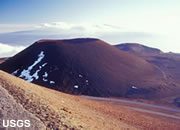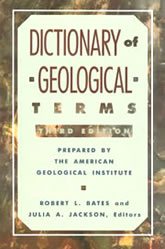Geological Terms Beginning With "C"
For terms beginning with other letters, please click below
|
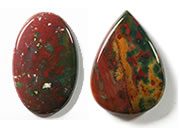
Cabochon
A cabochon is a stone or other material that has been shaped and polished rather than faceted. Stones that are cut en cabochon will typically have a front side that is domed and polished, while the back side is flat to allow it to be mounted in jewelry. Cabochons (or "cabs") are often cut to be oval in shape, but can also be round, square, rectangular, triangular, teardrop-shaped, or a freeform shape. Shown here are two cabochons of bloodstone.

Calcrete
"Calcrete" is a shallow soil or sediment layer in which the particles are cemented together by calcium carbonate mineral matter. It is a common feature of arid or semiarid areas throughout the world. Calcrete soils are associated with poor soil drainage, difficult soil conditions for plant growth, and excavation problems at construction sites. Other names commonly used for calcrete are caliche and hardpan.
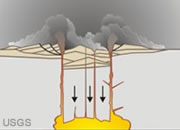
Caldera
A large, bowl-shaped crater associated with a volcanic vent. A caldera can form when a volcanic blast or the collapse of a volcanic cone into an emptied magma chamber produces a depression. Large calderas exist at Crater Lake and Yellowstone.

Caliche
"Caliche" is a shallow soil or sediment layer in which the particles are cemented together by calcium carbonate mineral matter. It is a common feature of arid or semiarid areas throughout the world. Caliche soils are associated with poor soil drainage, difficult soil conditions for plant growth, and excavation problems at construction sites. Other names commonly used for caliche are calcrete and hardpan.
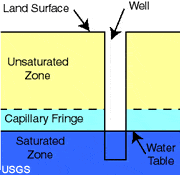
Capillary Fringe
The lower part of the "unsaturated zone" where some moisture is transmitted up from the water table by capillary action.

Carbonate Rock
A rock made up primarily of carbonate minerals (minerals containing the CO3 anionic structure). Limestone (made up primarily of calcite - CaCO3), dolostone (made up primarily of dolomite - CaMg(CO3)2), and marble (metamorphosed limestone or dolomite) are the most commonly encountered carbonate rocks. The example photo shows a piece of limestone.
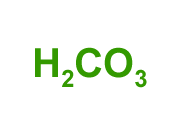
Carbonic Acid
A weak acid (H2CO3) that forms from the reaction of water and carbon dioxide. Most rain water is a very weak carbonic acid solution formed by the reaction of rain with small amounts of carbon dioxide in the atmosphere.
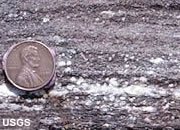
Cataclastic Rock
A rock composed of rock fragments formed by crushing and shearing during tectonic movements. The rock fragments can be as small as a powder or as large as several feet across. The original rock types may have been sedimentary, igneous, or metamorphic, but the cataclastics themselves are often metamorphic because of their heat and pressure exposure. Cataclastite, mylonite, and tectonite are examples of cataclastic rocks. See larger photos by USGS.
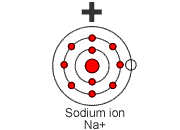
Cation
An atom with a positive charge that has been produced by the loss of one or more electrons. In the image, a sodium atom lost the one electron in its outermost shell and is now a sodium ion with a positive charge.
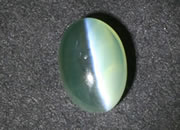
Cat's-Eye
Also known as "chatoyance." An optical phenomenon in which a band of white light moves just under the surface of a cabochon-cut gemstone. The band is caused by light reflecting from parallel tubes, fibers, or other linear inclusions within the stone. The band moves back and forth beneath the surface of the stone as the stone is moved under a source of incident light, or as the source of the light is moved, or as the eye of the observer is moved. This phenomenon is characteristic of chrysoberyl and tiger's-eye but is also seen in many other minerals including actinolite, tourmaline, apatite, beryl, sillimanite, and scapolite.
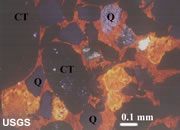
Cement
A solid precipitate of calcium carbonate, silica, iron oxide, clay minerals, or other materials that forms within the pore spaces of a sediment and binds it into a sedimentary rock. In the photo at left, the orange-brown material is a carbonate cement binding pebbles of chert (CT) and quartz (Q). See larger photo by USGS.

Cementation
The processes through which dissolved substances in pore water precipitate between the grains of a sediment and bind it into a sedimentary rock.
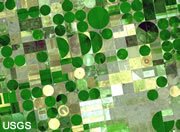
Center Pivot Irrigation
A circular area that might be between a quarter mile and a mile in diameter that is planted with crops and supplied with water from a well in the center of the circle. The water from the well is distributed by a long beam that stretches across the radius of the circle. The beam is covered with sprinkler heads and supported with wheels and one or more motors that drive the beam around the circle, distributing water over the crops. Also called "irrigation circles" or "crop circles." The photo is a satellite image of center pivot irrigation sites in Finney County, Kansas.
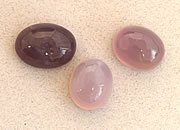
Chalcedony
Chalcedony is a name used for any cryptocrystalline quartz such as agate, jasper, petrified wood, chrysoprase, bloodstone, onyx, sard, and carnelian. Some people reserve the name for a blue, unbanded, translucent material. The photo shows specimens of pink to purple chalcedony cut en cabochon.



Chatoyancy
Also known as "cat's-eye." An optical phenomenon in which a band of white light moves just under the surface of a cabochon-cut gemstone. The band is caused by light reflecting from parallel tubes, fibers, or other linear inclusions within the stone. The band moves back and forth beneath the surface of the stone as the stone is moved under a source of incident light, or as the source of the light is moved, or as the eye of the observer is moved. This phenomenon is characteristic of chrysoberyl and tiger's-eye but is also seen in many other minerals including actinolite, tourmaline, apatite, beryl, sillimanite, and scapolite.
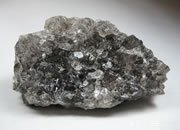
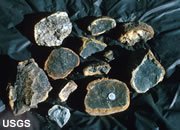
Chemical Weathering
The breaking down of rock material at or near Earth's surface by solution or chemical alteration. Common alteration processes are oxidation and hydrolysis. The broken, gray igneous rocks in the photo at right have orange weathering rinds caused by alteration of mineral grains exposed to the environment on the rock's surface. See larger photo by USGS.

Chert
A microcrystalline or cryptocrystalline sedimentary rock composed of SiO2. Occurs as nodules and concretionary masses and less frequently as a layered deposit. It may form through chemical or biological activity.
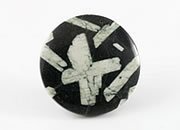
Chinese Writing Stone
A very interesting black metamorphosed limestone that contains geometric crystals of andalusite. "Chinese writing stone" is a trade name for the gem material used because some people think the white andalusite crystal shapes remind them of "Chinese writing."

Christmas Tree
The valves, gauges, and fittings installed at the surface at the top of an oil or gas well. These measure, control, and direct the flow of formation fluids produced from the well. Image copyright iStockphoto / SGV.
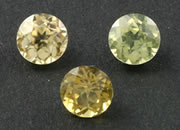
Chrysoberyl
Chrysoberyl, a gem unrelated to "beryl," is an "extreme gem." It has a hardness of 8.5, a very high luster, and a high index of refraction. It is sometimes a color-change stone and is best known for its "cat's-eye."

Chrysoberyl Cat's-Eye
Chrysoberyl often contains oriented inclusions that produce a sharp line of light across the surface of a cabochon-cut stone in reflected light. This optical phenomenon is known as a "cat's-eye." Chrysoberyl is thought to have the finest cat's-eye of any mineral.
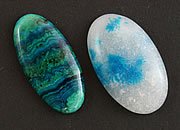
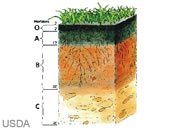
C-Horizon
The lowest horizon of a soil profile. It is below the B-horizon and immediately above the bedrock. It is a rocky zone that consists mostly of partially weathered bedrock and the weathering products of the least-resistant minerals in that bedrock.
Cinder Cone
A cone-shaped hill that consists of pyroclastic materials ejected from a volcanic vent. The photo at left shows a cinder cone and landscape covered with red scoria at Mauna Kea, Hawaii.

Cirque
A bowl-shaped depression with very steep sides that forms at the head of a mountain glacier. Forms from cold-climate weathering processes including frost wedging and plucking.
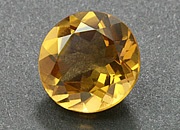

Clast
Rock fragment or mineral grain produced by the breakdown of larger rocks. The image shows gravel-size clasts found on the surface of Mars by Mars Rover Curiosity in 2012. The largest particle in the photo is about one centimeter in length.

Clastic
A type of sedimentary rock (such as shale, siltstone, sandstone, or conglomerate) or sediment (such as mud, silt, sand, or pebbles). Clastic rocks are accumulations of transported weathering debris that have been lithified.

Clay
A clastic mineral particle of any composition that has a grain size smaller than 1/256 mm. The term is also used in reference to a broad category of hydrous silicate minerals in which the silica tetrahedrons are arranged into sheets. Clay minerals are the typical weathering product of feldspar minerals and make up a major portion of many soils. The photo shows clay sediments that have dried in the sun to produce "mud cracks."

Coal
A brown or black sedimentary rock that forms from accumulated plant debris. A combustible rock that contains at least 50% (by weight) carbon compounds.
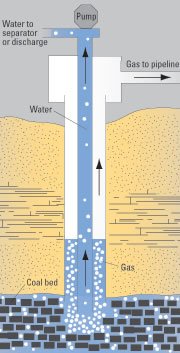
Coalbed Methane
Natural gas in the form of methane that occurs within some coal seams and is adsorbed onto the solid portion of the coal. It presents an explosion hazard to miners if it desorbs and accumulates in the air of the mine. If a coal seam has not been mined in an area, the methane can sometimes be commercially produced by drilling into the seam and pumping out water. The removal of water reduces the pressure within the seam and allows the methane to desorb from the coal. The gas produced from the coal may contain carbon dioxide and nitrogen in addition to the methane. These gases must be processed out to produce a salable product.
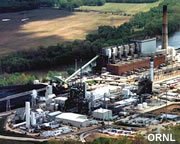
Coal Gasification
The process of converting solid coal into a gas, usually by heating or by the introduction of an oxidizing agent such as oxygen. The gas is then used directly as a fuel, processed into a chemical, or converted into a liquid fuel. Coal gasification can occur on Earth's surface in a processing plant, or it can occur in unmined coal seams deep underground.
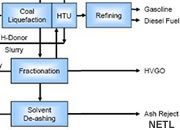
Coal Liquefaction
The process of converting solid coal into a liquid fuel such as synthetic crude oil or methanol. There are multiple processes that have been done successfully. They might involve contacting the coal with a catalyst at high temperatures or first converting the coal into a gas and then converting it into a liquid. Two of the main liquids produced are synthetic gasoline and diesel fuel.
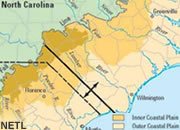
Coastal Plain
An area of low relief along a continental margin that is generally underlain by thick sediments that dip gently toward the ocean. The sediments were derived from the weathering and erosion of elevated areas of the continent and delivered toward the coast by streams. This area usually begins at the coast and extends inland to the first occurrence of elevated land.
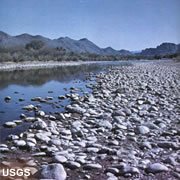
Cobble
A term used for a sedimentary particle that is between 64 and 256 millimeters in size. Cobbles are larger than pebbles but smaller than boulders. Cobbles have typically been rounded by abrasion during sedimentary transport. The image shows cobbles on the bank of the Salt River below Stewart Mountain Dam in Arizona.

Coherent
A rock or other aggregate that is resistant to breaking apart, well cemented. The photo shows a well-cemented and coherent specimen of conglomerate.
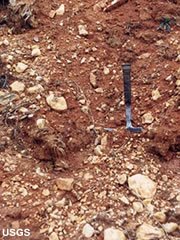
Colluvium
A loose accumulation of soil material and rock fragments deposited by a combination of runoff and mass wasting that is often seen at the base of a slope or outcrop. The image shows an accumulation of vein quartz and silty soil in Frederick County, Maryland.

Colored Diamonds
Colored diamonds are diamonds with a noticeable bodycolor when viewed in the face-up position. They can be yellow, brown, green, red, orange, pink, blue, or any other color.
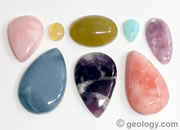
Common Opal
Common opal is an opal material that does not exhibit a "play-of-color." Most common opal is common in appearance, but some is spectacular in color or pattern. There are many types of opal.
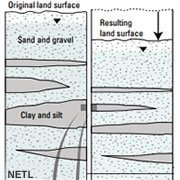
Compaction
A compression process that reduces the volume of a sediment as accumulating sediment above adds increasing weight. This volume loss occurs by: 1) repositioning the grains into a tighter packing; 2) deforming the grains into a tighter packing; and, 3) squeezing fluids out of the pore spaces. Compaction is one of the first steps in converting a sediment into a sedimentary rock. Normally, compaction preferentially occurs in fine-grained clay and silt layers of a sediment mass. Their grains are initially deposited in random orientations without grain support. These have the most potential for improved packing and deformation.

Completion
The final step in drilling of an oil or gas well. If the well is a "dry hole," the well must be plugged and the drilling site reclaimed in the manner described in the well permit. If the well is to be a "producer" then casing, tubing, and production equipment must be installed that will allow the well to yield product into a tank or into a pipeline. If the well is to be used for "injection" then, casing, tubing, and connections must be installed that will allow the connection of injection equipment and a supply of injection fluids.
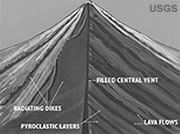
Composite Cone
A cone-shaped volcanic mountain composed of alternating layers of pyroclastic materials and lava flows. Also known as a stratovolcano. Most of the volcanoes in the Cascade Range are stratovolcanoes.
|
Dictionary of Geological Terms - Only $19.99 All scientific disciplines have an essential vocabulary that students and professionals must understand to learn and communicate effectively. A geology dictionary that is used regularly is one of the most important tools for developing professional competence. A good dictionary should be on the desk of every geologist and within easy reach. This dictionary is compact and inexpensive at only $19.99. More information. |
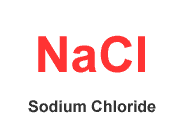
Compound
A pure chemical substance made up of at least two different elements. A compound is defined by the elements that it contains, the relative proportions of those elements, and its atomic structure.
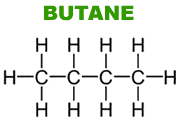
Condensate
Components of natural gas other than methane that are in the gaseous state under the high temperatures and pressures of the subsurface reservoir, but when they are produced at the lower temperatures and pressures of the surface they condense into a liquid. These "natural gas liquids" vary in composition and abundance from one well to another and even from one formation to another in the same well. They can include hydrocarbons such as pentane, butane, propane, hexane and others. These liquids are separated from the raw gas and have commercial value. In some areas they are more valuable than the methane that is produced. Raw natural gas that contains condensates is known as "wet gas."
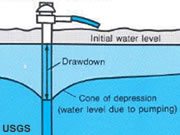
Cone of Depression
A cone-shaped lowering of the water table around a producing well. As water is pumped, the water level in the well falls, and width of the cone increases. When pumping stops, the cone shrinks in size because water from adjacent lands flows in to fill it.
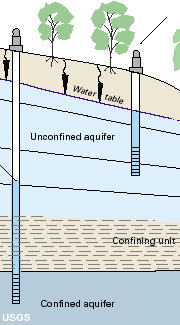
Confined Aquifer
An aquifer that is overlain by an impermeable confining unit and does not have a porous connection to the atmosphere through which it can receive recharge. In the image at left, the well on the left penetrates a confined aquifer. The shale confining unit above that aquifer blocks its porous connection to the atmosphere. The water level in the well has moved up above the top of the confined aquifer because that aquifer is under pressure.
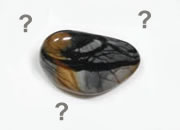
Confusionite
Confusionite is a rock, mineral, or other material that a person wants to identify but they are unable to identify confidently. The person might be a beginner at specimen identification, or the person might have great expertise but the specimen is outside of their range of skills, tools, or knowledge. Some specimens are challenging because they do not exhibit the typical characteristics of their species, often because they are a mixture of materials that produce conflicting results (e.g. sometimes barite will effervesce because it naturally contains calcite or because a previous investigator tested the specimen with a piece of calcite from a Mohs hardness set.) Confusionite is most often encountered in the field or in laboratories and offices where x-ray, chemical, or microscopic analysis equipment is not readily available. Most students encounter confusionite during geology lab exams. Children are experts at discovering specimens of confusionite because they pick up the unusual specimen instead of the typical.

Conglomerate
A clastic sedimentary rock that contains rounded pebble-size particles (greater than two millimeters in diameter). The space between the pebbles is generally filled with smaller particles and/or a chemical cement that binds the rock together.
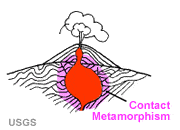
Contact Metamorphism
Alteration of a rock, mainly by heat and reactive fluids, which occurs adjacent to a dike, sill, magma chamber, or other magma body. Rock in the area of contact metamorphism might not display foliation because directed pressure is usually not involved. Hornfels is a common rock produced by contact metamorphism.
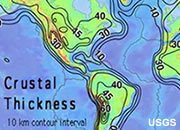
Contour Line
A line on a map that traces locations where the value of a variable is constant. For example, contour lines of elevation trace points of equal elevation across a topographic map. All points on the "ten foot" contour line are ten feet above sea level. The sample map at left shows crustal thickness in kilometers for North and South America.

Contour Map
A map that shows the change in value of a variable over a geographic area through the use of contour lines. The sample map at left shows crustal thickness in kilometers for North and South America.
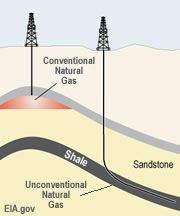
Conventional Oil and Gas
Crude oil and natural gas that can be produced by drilling a well into a rock unit and the characteristics of that rock unit allow the oil and gas to naturally flow into the well bore. The rock unit has adequate porosity and permeability to allow the oil and gas to move to the well, and, the oil and gas is not adsorbed to or bound within the grains of the rock.
Conventional oil and gas are usually produced from highly porous and permeable rocks, such as sandstones, where the anticlines, faults, or stratigraphy form traps that contain the gas. The oil and gas may have formed a great distance away from the well and migrated into the trap through pore spaces. Their migration was most likely a result of the oil and gas being lighter than the formation water and they moved upwards through the permeable rock until they encountered an impermeable seal that limited their movement.
Unconventional oil and gas and conventional oil and gas do not differ in their chemical composition. They differ in the type of rock unit from which they are produced.
Techniques like hydraulic fracturing, horizontal drilling, steam flooding, injection of water, injection of carbon dioxide, or pressure reduction - techniques that are intended to liberate the oil and gas from the rock or force it to the well - are not needed to produce conventional gas. Unconventional oil and gas are produced from shale, tight sands, and coal beds, where liberating the oil and gas from the rock and moving it to the well are the challenges. Compare to "unconventional oil and gas."

Convergent Boundary
A boundary between two lithospheric plates that are moving towards one another. One plate normally overrides a second plate that is pushed down into the mantle. Structural features in these areas are generally consistent with compression.

Coral
Coral is a colonial organism that lives in warm, shallow marine waters and often develops reefs. It is a hard calcium carbonate material that can be cut or carved and polished into beautiful organic gems.
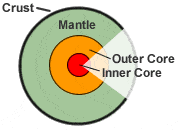
Core
A major subdivision of Earth's structure. It is the innermost part of the Earth and consists of a liquid outer core of molten iron, nickel, and other elements. The inner core is a solid composed mainly of iron, nickel, and other elements. The core is about 4200 miles in diameter.

Core
A cylindrical piece of rock obtained from a subsurface rock unit by drilling with a hollow drill bit, then brought up to the surface for examination. Samples of sediments, ice, and other subsurface materials can also be obtained with this method. This word is also used as a verb and an adjective.
The photo shows several pieces of core, about four inches in diameter, that have been sawn in half for flat-surface examination and stored in cardboard core-storage boxes. Cores like these will be arranged in boxes to represent their vertical sequence in the well, measured, carefully described, and photographed. The upper left corner of the photo shows some coal that broke into small pieces during drilling and handling. This often occurs with fragile rocks. The top left and bottom right corners of the photo show small signs that represent the number of feet below the surface where this sample was recovered. The core in these boxes represents the depth interval from 3280 feet below surface to 3296 feet below surface. The yellow tag at top left identifies the project for which the core was drilled, and the colorful piece of cardboard at left is a color reference. Newsprint has been crumpled and stuffed into the box to hold the core in place and prevent additional breakage.
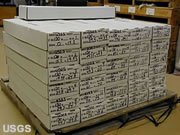
Core Box
A heavyweight corrugated plastic or cardboard box for storing core from a drilled well. The photo here shows a pallet of core boxes, each weighing about fifty pounds. The definition of the word "core" above shows an open core box with measured core in place. Storage of core requires a large amount of space and equipment to move and shelve pallets of boxes. Throwing core away is a huge loss of information that was very expensive to collect.

Core Catching Tray
A plastic or metal tray that is used to catch and support core as it is extruded from the core barrel. The core can be a solid cylinder of rock, a solid cylinder of mud, fragments of broken rock, or a muddy mess. The core catching tray keeps fragments of material in their proper order as they are extruded.
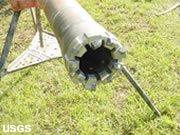
Coring Bit
A hollow cylindrical drill bit used for cutting a cylinder of rock, called a "core," from a well. The bottom of the bit is made of metal with embedded diamond abrasives for grinding through rock. As the bit cuts down through the rock, the "core" is contained within the last section of drill pipe. About every thirty feet, all of the drill pipe and the drill bit are pulled from the well so the core can be lifted to the surface and removed. Coring is very slow and very expensive work.

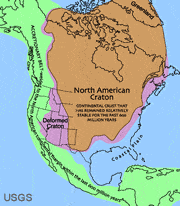
Craton
The name given to the stable (usually interior) portions of continental lithospheric plates that have not been deformed or metamorphosed for at least one billion years. Cratons are usually underlain by crystalline basement rock that is sometimes overlain by younger sedimentary rocks.
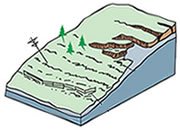
Creep
An imperceptibly slow, steady, downward movement of soil and rock material on a slope. The shear stress that drives the movement is strong enough to deform but too weak to cause failure. Creep is often most active during times of the year when moisture and temperatures facilitate movement. Curved tree trunks, tilted posts, leaning walls, cracked masonry, cracked pavement, and surface ripples can be signs of creep.
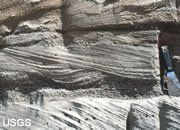
Cross-Bedding
A sedimentary structure in which a horizontal rock unit is composed of inclined layers. Sand deposited on the downwind side of a sand dune or sand deposited on the downcurrent side of a rivermouth bar will likely produce a horizontal rock unit composed of inclined layers. The tilt of the beds has nothing to do with post-depositional deformation.
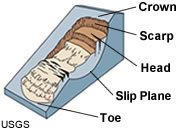
Crown
The undisturbed area upslope from the scarp of a landslide. This area is usually at risk because the slide below has removed support.
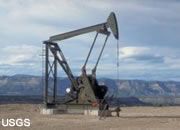
Crude Oil
A liquid hydrocarbon produced from natural underground reservoirs. It might also include liquid hydrocarbons produced from tar sands, gilsonite, and oil shale. Crude oil can be refined into a number of petroleum products which include heating oil, gasoline, diesel fuel, jet fuel, lubricants, asphalt, ethane, propane, butane, and many other products.

Crust
A major subdivision of Earth's structure. It is the outermost portion of the Earth. The oceans are underlain by a crust of mainly basaltic composition that ranges in thickness from about 3 to 6 miles. The continents are underlain by a crust of mainly granitic composition that ranges in thickness from about 20 to 30 miles.
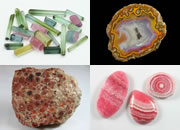
Crystal Habit
An external shape displayed by an individual crystal or an aggregate of crystals. A few examples of crystal habits are shown in the photo. Clockwise from top left: prismatic habit; geodic habit; banded habit; pisolitic habit.

Crystal Opal
Crystal opal is a term used for transparent-to-translucent opal material that has a play-of-color within the stone. There are many types of opal.
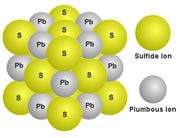
Crystalline
A material with an ordered internal structure of atoms that are in a regular and repeating arrangement through space. The image shows the ordered arrangement of sulfide and plumbous ions in the mineral galena.
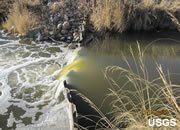
Cubic Feet Per Second
A unit of measure frequently used to quantify the rate of flow of water in a stream. It is equal to a volume of water that would pass through a cross-section that is one foot high and one foot wide flowing at an average velocity of one foot per second.
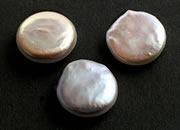
Cultured Pearls
Cultured pearls are produced by placing small "seeds" of shell material within a live mussel. The mussel then coats the seed with successive layers of nacre to form a pearl. They are produced in a variety of shapes, determined in part by the shape of the seed.
|
| More General Geology |
 |
Fossils |
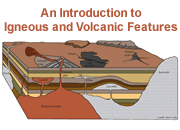 |
Igneous and Volcanic Features |
 |
Geology Dictionary |
 |
Diamonds |
 |
Minerals |
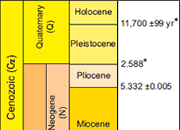 |
Divisions of Geologic Time |
 |
Land Below Sea Level |
 |
Gifts That Rock |

Find Other Topics on Geology.com:

|

| ||

|

| ||

|

| ||

|

|

